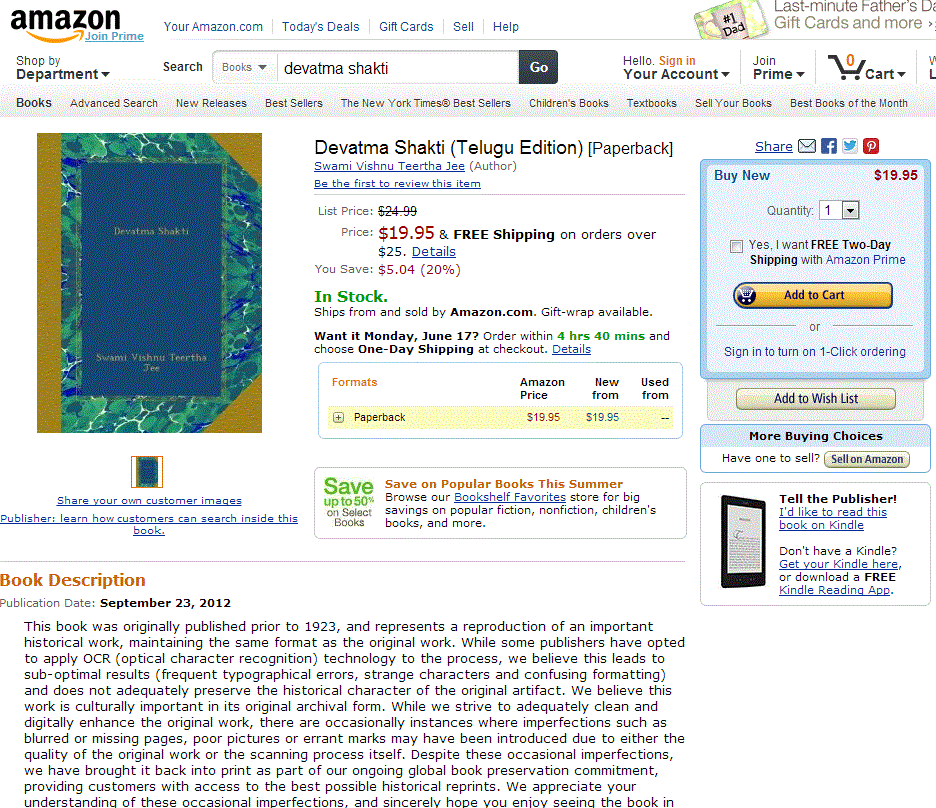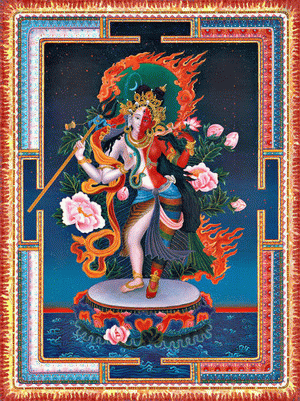Shakti (Kundalini) Divine Power. by Swami Vishnu Tirtha
Maharaj, with Forward by Mahamahopadhyaya Gopinath Kaviraj,
J.A., Formerly Principal, Government Sanksrit College,
Varanasi,1962
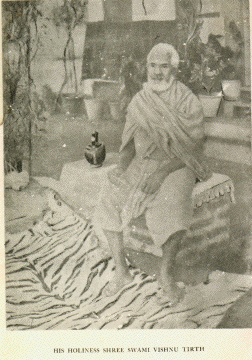
His
Holiness Shree Swami Vishnu
Tirtha
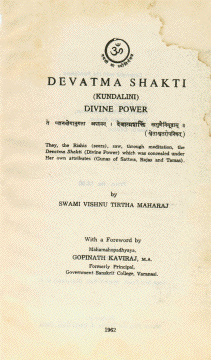
Chapter X

SIGNS OF AN AWAKENED
KUNDALINI
” According to her manifestations
Kundalini is regarded as Kriydwati, Varnamayee, Kalatma, and
Vedhamayee.”
Shaktipat deeksha is therefore of
four kinds according to the above-named manifestations of
Shakti. When Kundalini awakens one invariably feels some
involuntary movements of the body, which begin with
trembling and shaking -with an intensity varying with
different persons. Some experience violent shaking of
different kinds, as does a car before starting when the
dynamo, begins to work. Such physical movements are
accompanied with a heretofore-not-experienced feeling of
pleasure of spiritual awakening, and the brain becomes heavy
as under intoxication. – These are the first symptoms of an
awakened Kundalini and are followed by various signs and
experiences too many to be enumerated.
The full course of an awakened
Kundalini can be classified differently according to its
different aspects of manifestation, as Bhakti, Jnana, and
Yoga. Again manifestation of yoga can. be sub-classified as
Hatha, Mantra, Laya and Rajayoga. Therefore the yoga of
Kundalini is known as Mahayoga. It is also sometimes called
Siddhayoga because it can be acquired only through the
favour of a perfect master (Siddha Guru) without any effort
on the part of the initiated. Mahayoga is also sometimes
erroneously called Raja yoga after the name of one of its
most prominent part. Readers must have come across the
mention of only four divisions of yoga, viz., Karmayoga,
Bhaktiyoga, Rajayoga and Jnanayoga. An awakened Kundalini
comprehensively covers the whole field, but here we are
concerned with the subject only so far as it
pertains to the first
classification, because Bhakti is a necessary qualification
for all seekers after spiritual Truth. Divine Love or Bhakti
combined with yoga soon helps the devotee to attain
Brahmajnana, i.e., knowledge of God. Karmayoga is simply the
performance of all duties for duty’s sake regardless of
fruits.. It is a settled fact that Moksha is not the result
of any action, but is only an act of realization. Without
knowledge of Brahman no moksha is possible, declare the
scriptures and the knower of Brahman becomes Brahman
himself. As it will be clear from the following verses
quoted here from Brahmanikam of Shri Vasudeva Brahmendra
Saraswati that realisation of Brahman comes only through the
favour of God and a kindly look of the master in the form of
Shaktipat.
is possible through the realization of Truth and not by any
other action. That realization consists in the knowledge of
the sameness of Brahman with Self, as is asserted by the
sayings of the Vedanta Philosophy. Such realization comes to
deserving persons through the favour of God and through
Shaktipat as a result of the direct look of a
Master.”
It has been said that through
Shaktipat kundalini of the favoured is soon awakened and
Mahayoga or Siddhayoga is the direct outcome. ‘In other
words Hathayoga, Mantrayoga, Layayoga and Rajayoga dawn on
the initiated by stages, if he possesses a strong faith and
Bhakti for both God and his Guru. Rajayoga is but another
name. for God realization and as such in effect a synonym
for Jnanayoga. When Rajayoga is mentioned different from
Jnanayoga it stands for the yoga of meditation Hatha,
Mantra, Laya, and Raja the fourfold classification of
Mahayoga may be defined as flows
Hathayoga pertains to the
evolutionary manifestation of kundalini on the Physical
plane. The term Hatha is, a word of two Sanskrit letters `
ha’ and ` tha’. ` Ha ‘, denotes the sun and ` tha’ denotes
the moon, and therefore the term Hathayoga means a union of
the sun and the moon. Therefore all practices of the body
that bring about the union of Ida and Pingala, prana and
apana, and the merger of mind in Prana form the subject of
Hathayoga.
Manifestation of kundalini on the
plane of speech is called Mantrayoga. It is for this reason
that a master wishing to awaken the kundalini of a person
initiates him or her by transmitting his force through some
word or words spoken to the initiated. Such word or words
are called Mantras, so called because by repetition of those
words the initiated is freed from the bonds of
Maya.
Psychic stage of spiritual
evolution on the plane of mental submergence into a state of
trance is called Layayoga. Usually this stage of mind , is
preceded successively by the concentration of mind: or deep
thinking leading finally to an abstractedness of mind. It
can also be achieved by fixing the mind on Antarnada, viz.,
certain sounds audible from inside resembling the sounds of
chiming of bells, flute, drum-beating, and thunder, etc..,
and are called the music of Anahat Nada.
The plane on which Peace and
Light of spiritual Illumination shine forth is called
Rajayoga. Raja is a sanskrit word derived from the root Raj
to shine. Rajayoga is the ultimate realization of God within
one’s self. Rajayoga leads one to, the realization of
oneness with .Brahman, and therefore leads to Jnanayoga.
Evolution of kundalini on the plane of emotions, when all
base thoughts and emotions of anger, lust, etc., are
overpowered and subdued under the all-predominating emotion
of Love for God and everything spiritual, is called the
awakening of Allhadini Shakti and is
Bhaktiyoga.
Kriyawati
Manifestation of Kundalini on the
plane of Hathayoga is known as Kriyawati. The initiated then
performs the manifold exercises of Hat ha yoga
involuntarily. He does not do them intentionally, but
undergoes the influence of the new born force automatically.
The exercises of Hathayoga are classified under the heads of
asanas, mudras, and pranayam. Under the influence of the
force of awakened Kundalini one performs them not
understanding the significance of what he does. He performs
many exercises not found in any treatise on yoga; they are
sometimes very intricate and difficult muscular exercises
quite hard to be practised otherwise. One without the
influence of the force of Kundalini is often quite unable to
twist one’s limbs in the requisite manner. Ordinarily more
important of these exercises are prescribed in text books of
Hathayoga for a novice for the purpose of arousing
kundalini, but strange it looks that the aroused Kundalini
also performs them very perfectly and in a way easy of
practice, refreshing and conducive to health and meditation.
Almost all the exercises pertain to the nerves of the spinal
system and do not disturb the function of the autonomous
system, though their effect on them is one of health and
regularity. Besides She makes a person do bodily movements
of other sorts such as walking, eating, laughing, weeping,
etc.
The autonomous system of nerves
including the sympathetic and the para-sympathetic systems
worked by Prana and the central system worked under volition
of mind are thus simultaneously affected by the aroused
power of kundalini and a neutralizing effect of both Prana
and Mind is experienced. First a partial neutralization
makes the mind lose its wavering nature and then complete
neutralization of the two causes complete suspension of
both. It should not be lost sight of that mind occupies a
subordinate position under Prana which controls every
activity – of mind and body.
The Atharva Veda therefore prays.
vide 11.4 (6) 1.:
whose control, is all this, who is the master of all and by
whom everything is supported.”
Control over prana automatically
affects control over mind and senses. Automatic performance
of exercises by the force of aroused Kundalini in a
systematic manner disconnects the mind from the nervous
system for the time and the mind thus freed from the nervous
activities acts as a mute spectator for that period, the
whole system autonomous and central becomes autonomous for
the time. The autonomous system also gains strength and
begins to work properly. It builds up health, removes
disorganization cures diseases and improves the tone of the
whole system. Mind detached from the nervous system also
gains strength and learns to stand aside mute at other times
as well, and acquires to some extent control over the
autonomous system also.
The exercises of Hathayoga as
performed by Kundalini are natural and as such when
practised voluntarily by any person for a sufficiently long
time help to arouse Kundalini. They are prescribed in
various treatises on Hathayoga, but they ought to be learnt
from an expert master and practised under his strict
guidance.
How these exercises are connected
with the rousing of the Kundalini is a matter for research,
though various attempts are being made to explain, their
action on the nervous plexuses, they are generally based on
vague speculations. Unfortunately we have yet no institution
worth the name where a batch of ardent and sincere students
with a good knowledge of anatomy and physiology with their
Kundalini aroused could take up the research work in that
direction. Generally anatomists and physiologists are quite
ignorant of and indifferent to this sphere of
study.
It appears most probable that
practice of these exercises, done either voluntarily or
involuntarily, acts on the spinal plexuses and as a reaction
on the autonomous one generate simultaneously opposite
charges of prana and apana in the two systems. The two
charges, if they be so called on the analogy of electric
charges, give birth to corresponding currents, which a yogi
feels and they can be made to flow up his spinal cord. When
the two forces rise up through chittra or the grey portion
of the spinal cord on both sides, right and left, they tend
to cause a neutralization or discharge of the opposite
dynamic forces through the empty canal at the different
spinal centres and ultimately rise up the medula oblangata
and cerebrum. With the complete neutralization of both the
forces in medula oblangata or higher up, a soothing and
peaceful effect on mind is produced which ultimately is
merged in a trance and gives effect to a stop to the
efferent and afferent impulses. Mind becomes vacant and with
the spent-up force of prana ultimately enters into
samadhi.

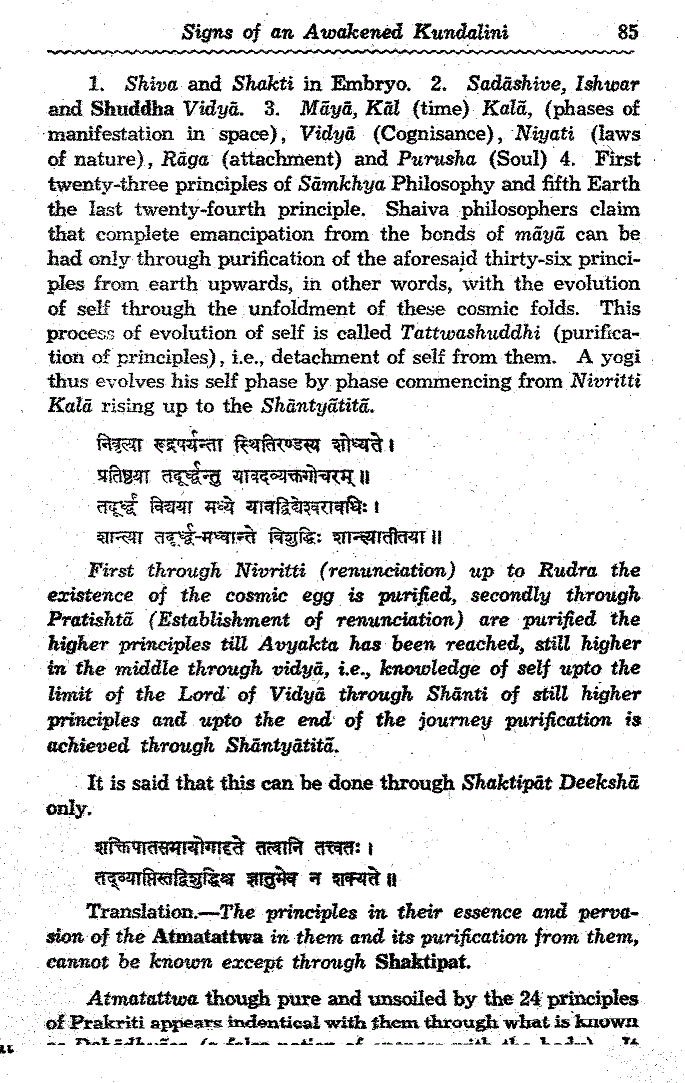
in the middle through vidya, i.e., knowledge of self upto
the limit of the Lord of Vidya through Shanti of still
higher principles and
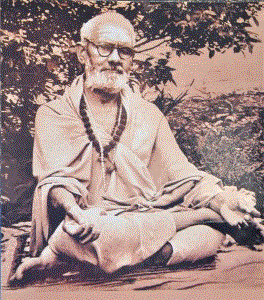
Table of Contents
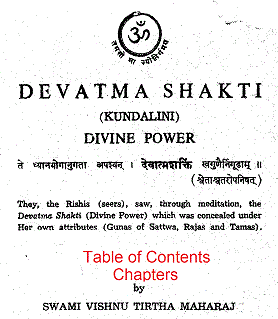
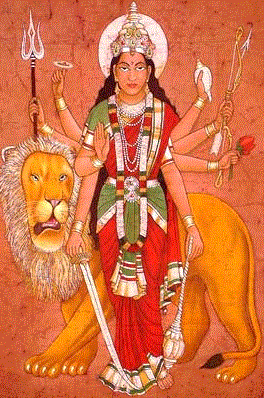
Buy Devatma Shakti on
Amazon
